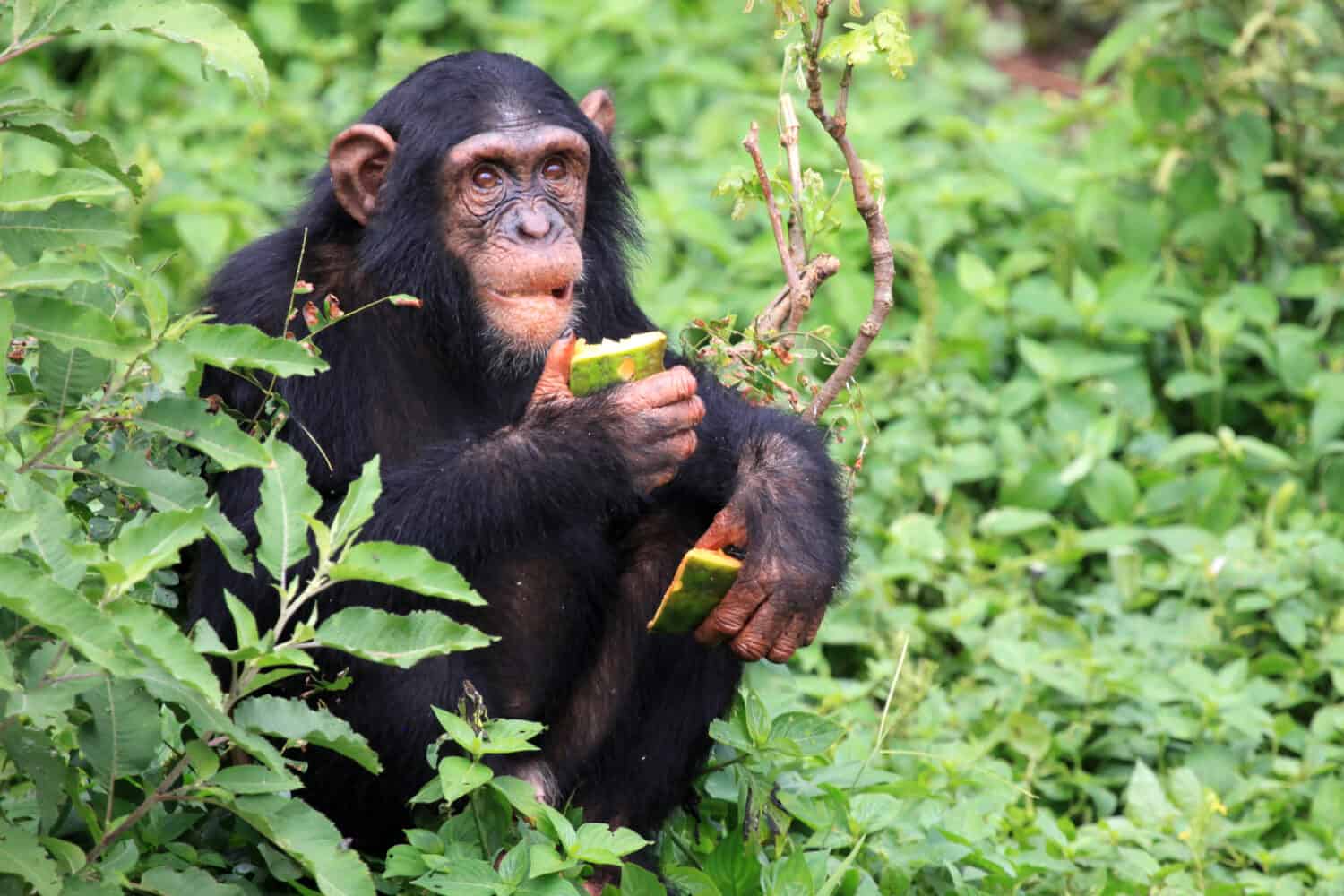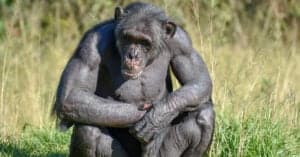Of all the great apes, the closest evolutionary relatives of human beings are the chimpanzees. Believe it or not, they share an astounding 98.8 percent of their DNA with humans! Intelligence tests place them at the mental level of a human toddler. They can learn up to 350 ASL signs and communicate with people! They experience human-like emotions and express them with similar facial expressions. Another way they are similar to humans is in their sexual dimorphism. This article explains general characteristics of this species, alongside key physiological and behavioral differences between male and female chimpanzees.
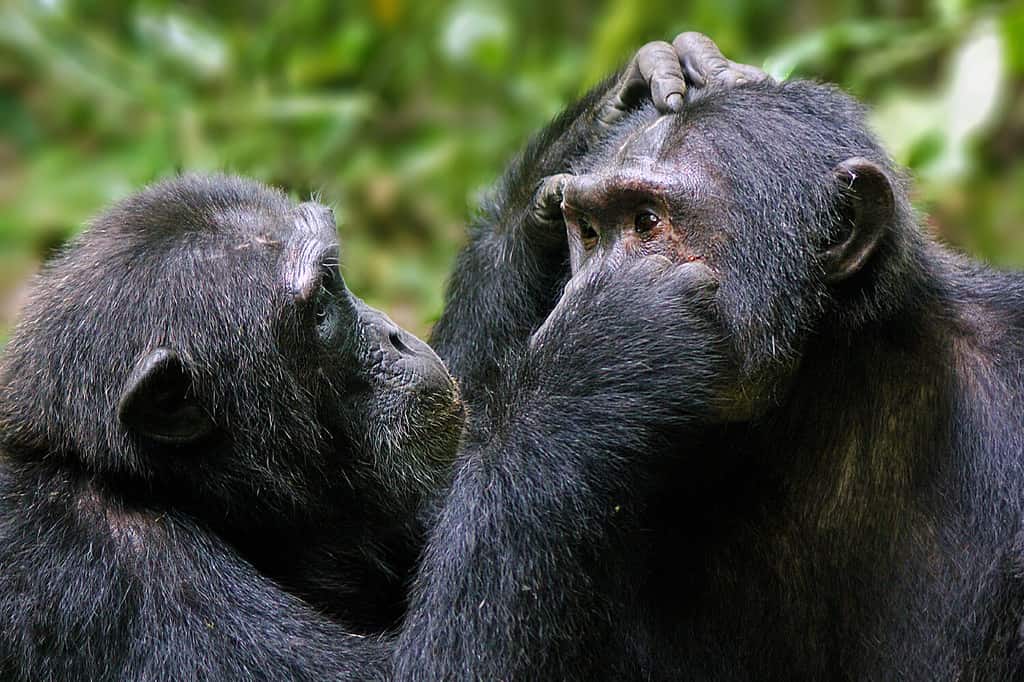
Chimpanzees share 98.8% of the same DNA as human beings.
©ThomasDeco/Shutterstock.com
General Characteristics of Chimpanzees
Physical Description
The scientific name of the chimpanzee is Pan troglodytes, and there are four subspecies. Like gorillas and humans, chimpanzees have no tails. They have bare faces, fingers, toes, palms, and soles, but the rest of their body is covered with rough, straight black, brown, or ginger hair. As they get older their hair can grey and develop bald patches. Chimps may live into their mid 40’s in the wild but in captivity can attain 58. In the most exceptional situations, they can live much longer. “Cheetah,” the chimpanzee that acted in the Tarzan movies of the 1930s and ’40s, reportedly lived to be 80 years old!
On average, chimps stand between 3-5 feet tall on their back legs and weigh up to about 154 pounds. That’s just an average though, and especially large chimps can reach 5’6″ and weigh 300 pounds. This is taller than a lot of people, including celebrities like Danny DeVito, Dolly Parton, and Kourtney Kardashian! Chimps can move around comfortably on two or four legs, or by swinging through trees. Their bodies are adapted for this form of locomotion. They have long, powerful arms, strong knuckles they can walk on, and fast-twitch muscles that make them 1.5 times stronger than humans.
Chimpanzee Behavior
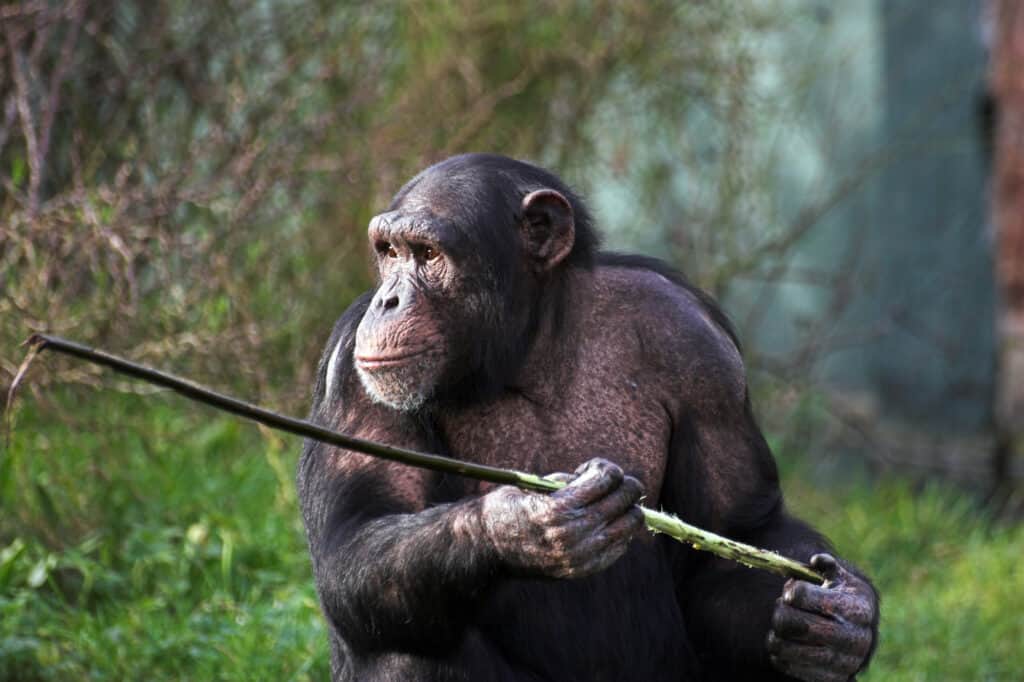
Chimpanzees make tools out of objects in their environment for feeding and defense.
©Norma Cornes/Shutterstock.com
Chimps live in communities of 15-150 but break up into smaller groups when they forage during the day. They are omnivores, eating fruit, nuts, leaves, fungi, flowers, honey, eggs, and small animals. Chimpanzees are one of the few animal species that make use of tools. They use sticks and stones as weapons against threats and will sharpen them to spear small animals. Chimps also use them to scratch themselves or scoop up water, termites, or honey. One of the differences between male and female chimpanzees is that females are more likely to use these kinds of tools. Incredibly, chimps also appear to use some herbs and minerals medicinally, to prevent and treat disease or parasite infections.
Chimpanzees mentally map their territory to be able to find resources again. Chimpanzees split their time between the forest floor and the tree canopy. They sleep tree nests, making a new nest every night instead of returning to the same one. Chimps are not able to swim, but they wade into the water to cool off, play, or forage for a meal.
Differences Between Male and Female Chimpanzees

Males have much larger canine teeth than females.
©Afandi Teguh Afriyanto/Shutterstock.com
Here are some of the most interesting differences between male and female chimpanzees:
Physical Differences
- The clearest of all the differences between male and female chimpanzees is their size. Males are heavier, at 88-154 pounds, than females, at 60-110 pounds.
- Males have much larger canine teeth than females. They use these not only for fighting but to break open seeds and fruit with hard shells.
Behavioral Differences
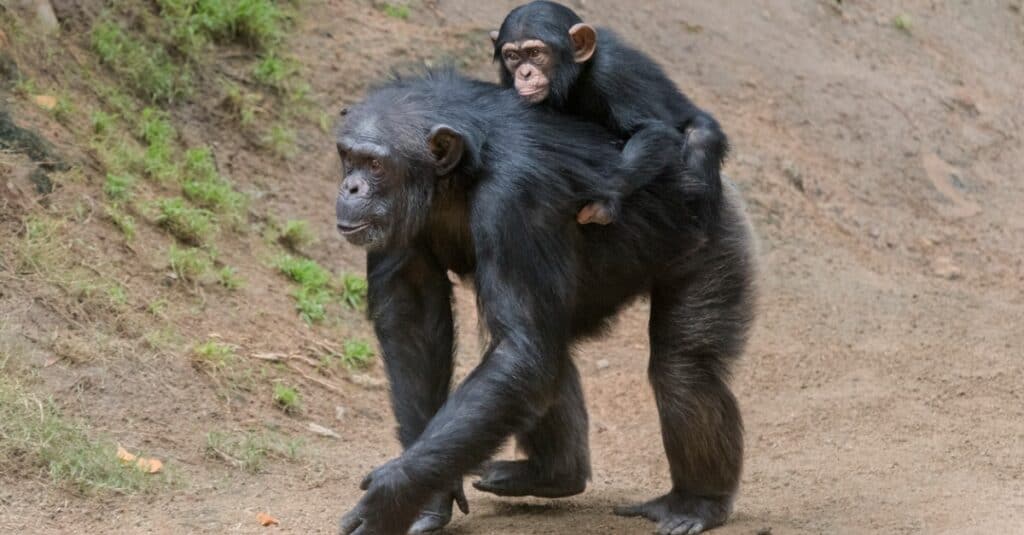
From about six months to two years of age, baby chimps cling to their mother’s fur and ride everywhere.
©iStock.com/JeannetteKatzir
- Adult males are somewhat more likely to walk on two legs and climb more whereas females more often go about on all fours.
- One of the most significant differences between male and female chimpanzees is in personality. Males are more social with one another. Females are more timid and shyer. They usually stay to themselves or with their own offspring rather than associating with other chimps.
- Females are more likely to use tools than males.
- Infants and juveniles sleep with their mothers at night, not their fathers. This is the only exception to the adult chimp practice of sleeping alone in a nest at night.
- Females take primary responsibility for caring for their young. However, even though they are sexually promiscuous, males can recognize their own young and sometimes help groom, feed, and play with them.
- Both males and females sometimes kill infant chimps but for different reasons. Females may cannibalize infants of lower-ranking females due to scarce resources. Males who are rising in status may kill infants of lower-status chimps to solidify their new, higher position in the hierarchy.
Sexual Differences
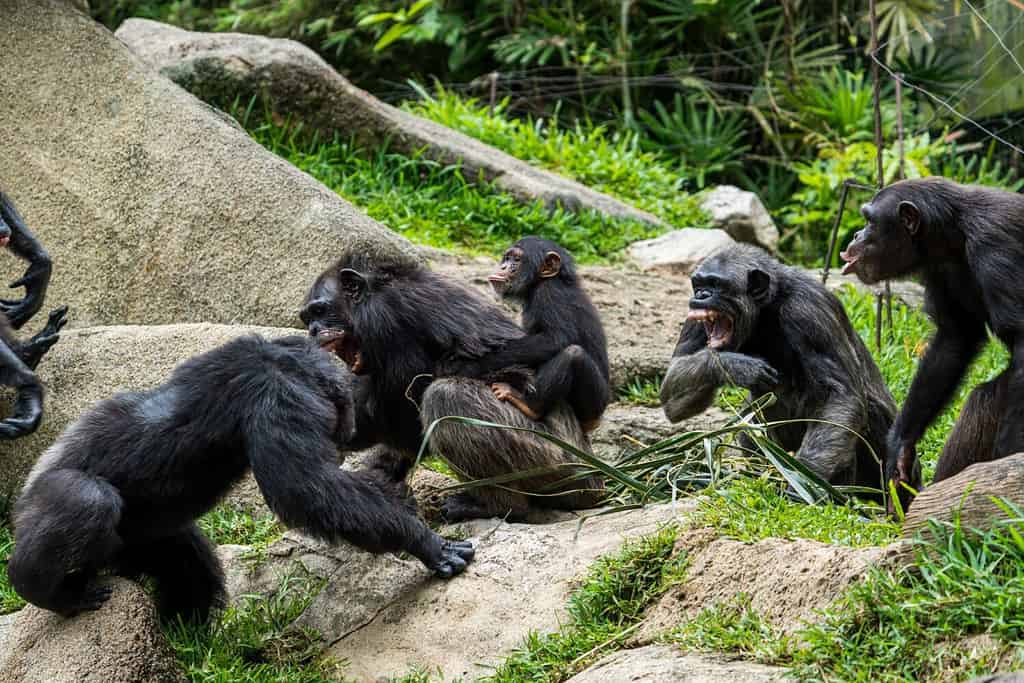
Chimpanzees can be peaceful, loving, and social, but they can also fight violently with one another.
©Hit1912/Shutterstock.com
- Females reach sexual maturity at 13, while males don’t reach maturity until the age of 16.
- Females prefer to mate with a male who has a stable place in the social hierarchy, as the offspring of males who are not in a strong position are vulnerable to violent, dominant males. Males, on the other hand, often prefer to mate with an older female as she is more likely to be fertile than younger females.
- When females are ovulating, their bottoms become noticeably swollen and red to attract males. Males are able to distinguish females by their buttocks, to help prevent inbreeding with their offspring.
- Adult males often use violence toward females to force them to mate and prevent them from being with other males. Females are not as strong and do not typically use violence in mating.
Social Differences

An alpha female can become second in status to an alpha male, with all other males subordinate to her.
©Wirestock/iStock via Getty Images
- Chimpanzee communities are patriarchal. Male chimps form alliances and share a large territory.
- The most dominant female can become more powerful than all the males except the alpha male.
- Males compete violently with one another for status. Females fight less for status between themselves.
Chimpanzee Conservation
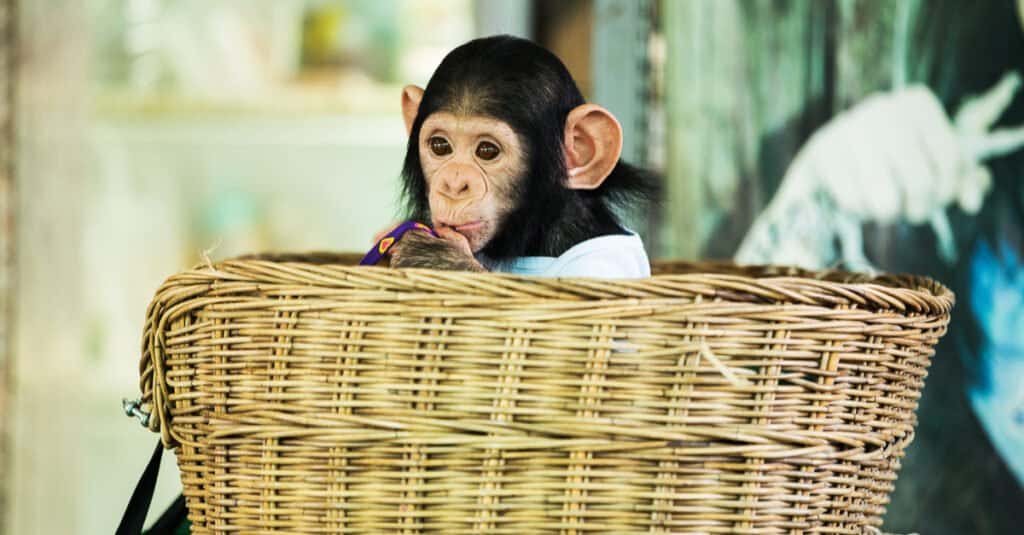
Baby chimpanzees are adorable but grow into uncontrollably strong and unpredictable adults.
©subin pumsom/Shutterstock.com
The International Union for the Conservation of Nature (IUCN) lists all chimp subspecies as endangered. There are about 170,000-300,000 chimpanzees remaining in the wild today. They actually have the largest remaining range of any of the great apes, but it is fragmented across 22 African countries. As with other species, one of the greatest threats to chimpanzees is the loss of habitat through deforestation and climate change.
Chimpanzees are also prey for lions, leopards, and other carnivores. Humans hunt them for meat and poachers kill mothers to take their babies for the exotic animal trade. The similarity of chimps to people makes them desirable for medical research, entertainment, and as pets among a wealthy clientele. Although they are cute as babies, wearing diapers and sucking on pacifiers, they quickly grow into large, dangerous, and unpredictable wild animals that can easily injure or kill a human being. So, they’re definitely a species best enjoyed in the zoo, not your home.
Thank you for reading! Have some feedback for us? Contact the AZ Animals editorial team.

